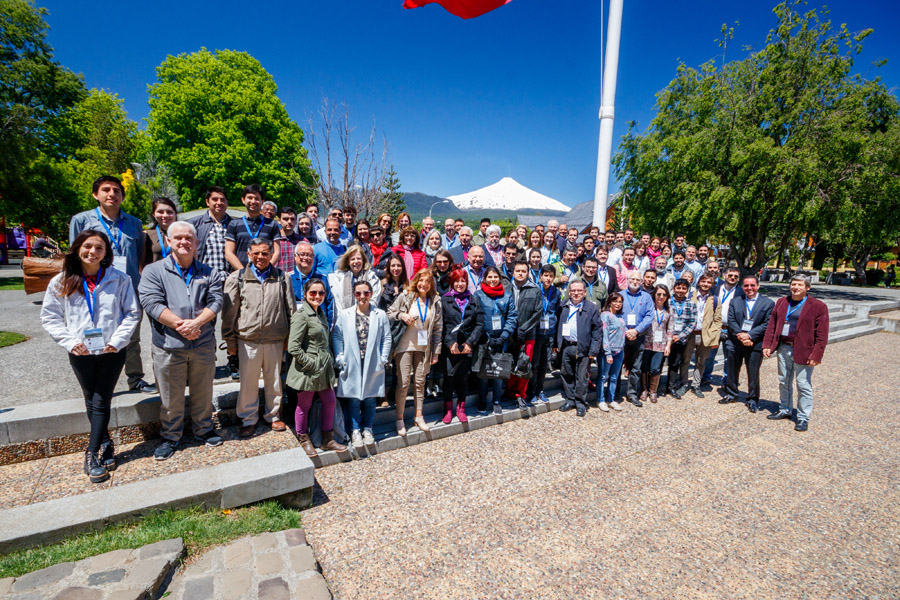|
The XVI Latin-American Conference of Analysis by X-ray Techniques (SARX 2018) and the VI. Conference on Medical Physics at La Frontera (JFMF 2018) were the two events that took place simultaneously and brought hundreds of researchers, teachers and undergraduate and postgraduate students from Chile and other countries together in the Araucanía Region. |
“Science starts with actions”. With this in mind, Dr. Rodolfo Figueroa, researcher at the Department of Physical Sciences of the Universidad de La Frontera, assumed the challenge of organizing and developing two parallel international events for the dissemination of science regarding x-ray techniques and medical physics. The XVI. Latin-American Conference of Analysis by X-ray Techniques (SARX 2018) and the VI. Conference on Medical Physics at La Frontera (JFMF 2018) were the two events that took place simultaneously and brought hundreds of researchers, teachers and undergraduate and postgraduate students from Chile and other countries together in the Araucanía Region. From November 6 to 9, the Pucón Campus of the UFRO was the headquarter of both events where they presented different contributions to the development and use of x-ray techniques in different industries and fields, such as mining and medicine, apart from other issues linked to medical physics. “Both congresses are related in some way. This is why we wanted to do them in parallel, in order to create links and the exchange of experiences between the participants and, on this occasion, with a main focus on medical physics,” Dr. Rodolfo Figueroa pointed out and added that the closing ceremony of both events was held on November 7, a date that has not been chosen randomly, since it is the International Day of Medical Physics. The structure of both events was similar, with conferences, oral presentations and poster presentations, among other activities oriented towards the update of knowledge and exchange of experiences between the participants. “The field of medical physics is relatively small compared to the other areas of physics or medicine and, although it has been existing for a lot of years, it is not quite known by the general public and even by a lot of professionals in the medical field, unless they have had the opportunity to interact or collaborate with medical physicists,” he explained. In this regard, he added: “These events are extremely important in order to help each other, especially in countries with low resources, where the profession is being developed through education as well as technical applications, scientific development and the development of applications,” Dr. Yakov Pipman, member of the American Association of Physicists in Medicine, confirmed. Dr. Ignacio Queralt of the Spanish National Research Council was also present in Pucón and said: “The interaction between scientific fields always requires progress in our knowledge, and synergistic activities between different disciplines always help. It is important that the level of education and research go hand in hand with the young professionals, and events like this one help us to fulfill this purpose.” It is worth stressing that within this strategy of promoting the early interest and training of specialists in applications of x-rays by bringing together experts and students, the International Centre for Diffraction Data (ICDD) supported the participation of students from different countries by providing 12 scholarships that covered the accommodation, as well as the Vice-rectorate for Academic Affairs of the UFRO, which provided 10 undergraduate students with scholarships that covered the inscription fee, and the Master´s Program in Medical Physics of the UFRO, which provided a similar benefit to its students. E-POSTERS One of the traditions at this kind of events is that different groups of the participants present a part of their research or the results in the form of a scientific poster. Instead of the traditional presentation of these posters, the organizing committee introduced an innovation by making use of technology in order to present each poster. This is why, on this occasion, the poster presentation gained special attention. The e-posters have been presented on four 55 inch screens that have been mounted in a vertical position on 1.20m high pedestals that have been especially made for this occasion and will be available for similar events at the university in the future. Written by: Daphne Bormann
Faculty of Engineering and Science |
